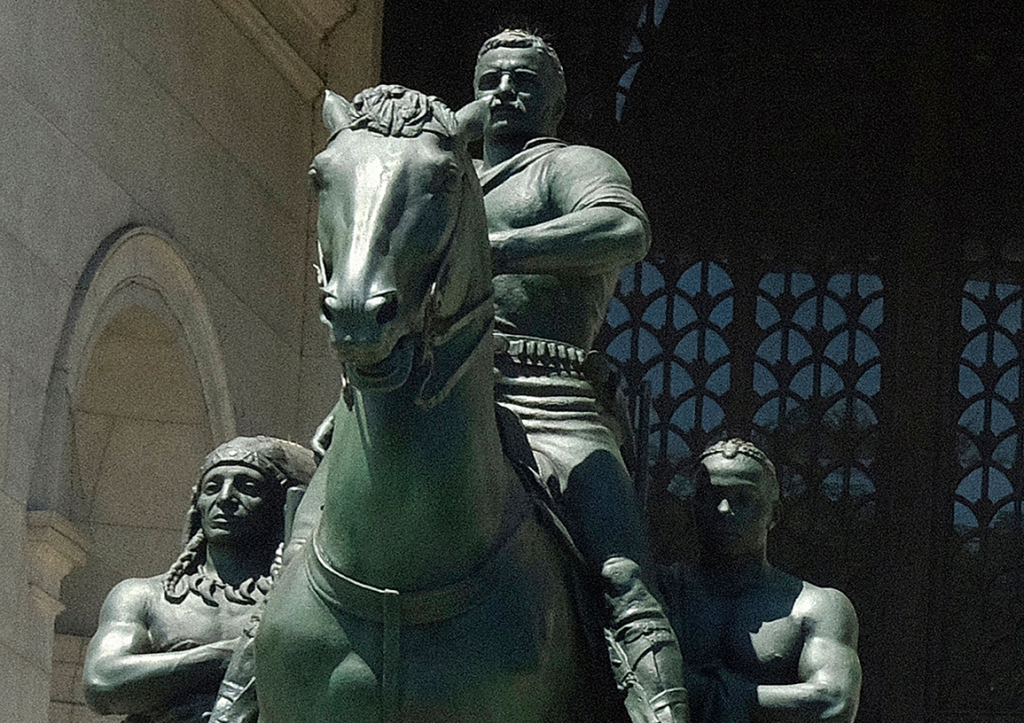[ad_1]
On Sunday, the American Museum of Natural History in New York revealed news that activists had been waiting years to hear: a monument to Theodore Roosevelt, a former United States president who espoused racist and colonialist views and who promoted eugenics as a theory, would at last come down. That statue may be one of many in the U.S. that has been set to be taken away amid ongoing Black Lives Matter protests, but it is one of the most notable—and controversial—ones slated for removal so far. To survey how the removal came to be slated, read below.
Activists have protested the Roosevelt statue for years. Why is it coming down now?
According to the New York Times, which first reported the news on Sunday, the American Museum of Natural History proposed removing the work to New York City, which owns the property on which the museum is situated, and the City accepted that proposal. The Black Lives Matter protests following the killing of George Floyd by Minneapolis have helped spur on the removal, for which a date has not yet been set. “The time has come to move it,” the museum’s director, Ellen V. Futter, said in a statement to the Times.
What, exactly, is the statue, and why did activists want to see it go?
The monument is what’s known as an equestrian statue, in which a subject—historically, a male leader or a military figure—appears atop a horse in an attempt to heroicize him. Activists claim that the treatment is ill-suited to Roosevelt, who served as the state’s governor from 1899–1900, because he was an outspoken proponent of eugenics, a theory that promotes white supremacy. (Later, after Roosevelt died, the Nazis made eugenics a central part of their ideology during World War II.) Protesters have also claimed that the two subjects flanking Roosevelt—a Black man and an Indigenous man—are “subjugated and racially inferior,” as New York City Mayor Bill de Blasio put it in a statement.
Had the museum done anything previously to acknowledge activists’ allegations?
Yes, but not enough, some said. In 2019, the museum unveiled an exhibition called “Addressing the Statue,” which aimed to explore the statue’s history using input from various experts, including Black and Indigenous scholars. (An online portal exists alongside the show taking place within the museum’s walls.) That exhibition did not shy away from the uglier parts of the museum’s history: it explored in depth how the Museum, which was founded by Roosevelt’s father, had itself previously pushed eugenics to its visitors. (Roosevelt’s great-grandson, Theodore Roosevelt IV, is also a trustee of the museum.) Some, including Mabel O. Wilson, who served on a city commission overseeing the statue, have said that the show did not effectively act as a substitute for removing the artwork altogether.
How did the statue get there in the first place?
In 1920, one year after Roosevelt died, the New York state legislature designated the museum as the site for a memorial to the former U.S. president and New York State governor. Five years later, in 1925, the statue was commissioned. And 15 years after that, in 1940, James Earle Fraser’s statue was officially dedicated and installed in front of the museum.
What did the artist want the sculpture to signify?
Fraser wasn’t exactly the most high-profile artist in the U.S. at the time—the New York Times once called him a “famous unknown sculptor”—but he had been steadily growing a reputation as a go-to guy for commissions done in a Renaissance-like style. Aesthetically, his work was conservative. Politically, his sculptures are harder to read. He’s most famous, still, for End of the Trail (1918), a sculpture of an exhausted-looking Dakota man on a horse who acts as a stand-in for Indigenous peoples who endured genocides waged across the United States, in particular the Trail of Tears. “I continue to have ambivalent feelings about this image, but I understand that for many it is a symbol of resilience and strength—characteristics traditionally associated with the warrior,” artist Jeffrey Gibson (Choctaw-Cherokee) once said.
Some have suggested that there is a similar level of political ambiguity with the Roosevelt monument, officially titled Equestrian Statue of Theodore Roosevelt. “The two figures at [Roosevelt’s] side are guides symbolizing the continents of Africa and America, and if you choose may stand for Roosevelt’s friendliness to all races,” the artist once said. And yet, not everyone has seen it that way, pointing to the differences in scale— Roosevelt physically rises above the Black and Indigenous men—as a sign that white supremacy is literally being upheld.
What forms have the protests against the work taken?
Each year since 2016, the group Decolonize This Place, working with a network of other activist coalitions, has staged an action on Indigenous People’s Day, the holiday founded as a protest against Columbus Day. Their actions have been intended to highlight the museum’s role in promoting colonialism, since Roosevelt himself had been an important figure in pushing U.S. imperialism around the turn of the 20th century. In 2017, red liquid was spattered across the statue’s pedestal by protesters who labeled themselves the Monument Removal Brigade. Those protesters said in a statement, “We did not make it bleed. It is bloody at its very foundation.”
What happens to the statue now?
It’s unclear. Officials have not yet announced a timeline for the work’s removal or any plans for what will happen to it once it is removed.
[ad_2]
Source link

